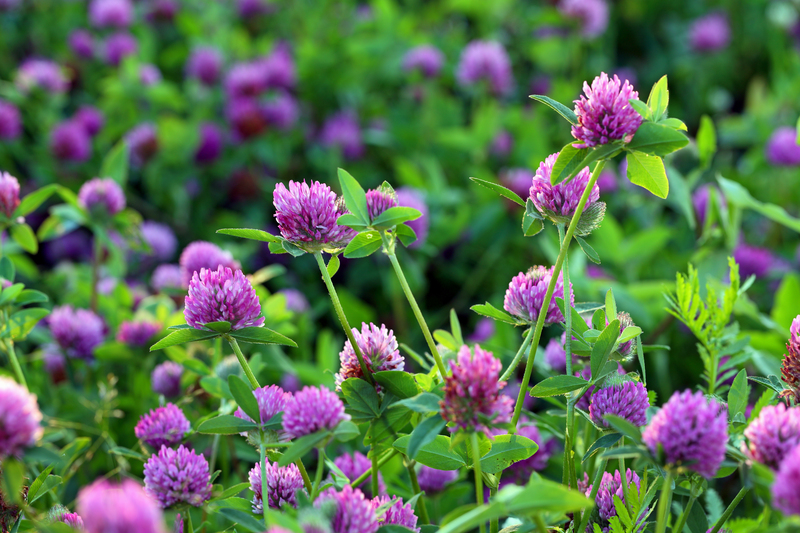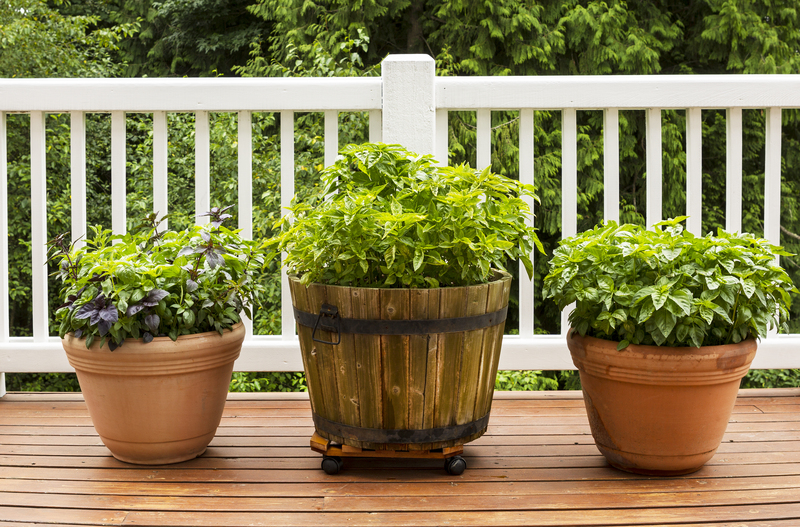Dog-Friendly Gardening Insights for Green Enthusiasts
Posted on 03/07/2025
Dog-Friendly Gardening Insights for Green Enthusiasts
For many passionate gardeners, the joy of nurturing a flourishing outdoor oasis goes paw-in-paw with the companionship of a beloved canine. Yet, merging your love for gardening with the needs of your four-legged friend does present a unique set of challenges. This comprehensive guide offers dog-friendly gardening insights highlighting inventive solutions and best practices to protect both your plants and your pup, ensuring a harmonious environment for all.

Why Pursue a Dog-Friendly Garden?
Dogs and gardens offer invaluable benefits to our lives--think exercise, stress relief, and a vital connection to nature. When gardeners and their pets share the same outdoor space, crafting a pet-safe garden becomes not only rewarding but essential. A canine-friendly garden design can:
- Prevent accidental poisoning from toxic plants
- Minimize digging and landscape damage
- Facilitate safe exploration and play
- Encourage natural behaviors like sniffing, chasing, and relaxing
- Promote both canine and human wellness
The Core Elements of Dog-Safe Gardening
1. Knowledge of Pet-Toxic and Pet-Safe Plants
Not all flora is created equal when it comes to dogs. While humans might relish a vibrant landscape filled with diverse species, some popular garden plants can be toxic to pets. Rigorous plant selection is the foundation of a dog-friendly landscape.
Common Toxic Plants for Dogs
- Oleander
- Foxglove
- Daffodils
- Azaleas
- Lilies (even though more dangerous to cats, some are toxic to dogs)
- Autumn Crocus
- Sago Palm
Note: Even a small amount of some of these can be life-threatening. Always check the ASPCA's Toxic and Non-Toxic Plants Database or consult your veterinarian before introducing new plants.
Dog-Friendly Plant Alternatives
- Sunflowers
- Camellias
- Sage
- Marigolds
- Rosemary
- Snapdragons
- Magnolia Bushes
Tip: Choose robust, hardy plants that can withstand the occasional canine trampling and are safe if nibbled.
2. Creating Playful Canine Paths
Dogs love to patrol their territory and often establish their own well-worn routes or "dog runs" through your yard. Instead of battling your dog's habits, work with them by actively incorporating canine paths into your garden plan.
- Mulched or flagstone walkways give dogs a designated route and can help preserve flower beds.
- Natural screening with robust, non-toxic hedges can help guide dog traffic away from sensitive areas.
Pro Tip: Observe your dog's favorite routes for a week, then formalize these paths with attractive, durable materials.
3. Fencing, Borders, and Enclosures
Physical barriers are often necessary for both plant and pet safety. But that doesn't mean compromising on aesthetics:
- Low picket fences or decorative garden gates keep dogs out of delicate areas.
- Raised beds or planters prevent digging and trampling.
- Chicken wire or mesh at the base of garden beds stops enthusiastic diggers.
4. Select Safe Garden Mulches
Some mulches, such as cocoa bean mulch, are highly toxic to pets. Opt instead for:
- Pine straw
- Cedar chips
- Natural wood bark (untreated)
- Pea gravel
Always avoid dyed or chemically-treated mulches.
5. Choose Dog-Safe Fertilizers and Pest Control
Many mainstream garden chemicals can harm curious pups. When nurturing a dog-safe backyard garden, natural is best:
- Compost or well-rotted manure for fertilizing
- Neem oil, insecticidal soap, or diatomaceous earth for pest control
- Manual weeding instead of herbicides
Note: Store all products--organic or otherwise--in sealed, pet-proof containers.
6. Incorporate Enrichment and Comfort Zones
Enhance your pet-welcoming garden with spots specifically designed for canine comfort and enrichment:
- Shaded rest areas with soft ground coverings like grass or mulch
- Water features such as fountains or shallow splash pools for cooling off
- Digging pits or sandboxes to channel natural digging instincts away from your prized borders
- Toy or treat stations that reward good behavior in the garden
Design Strategies for a Dog-Friendly Landscape
Embrace Zoning in Your Garden Layout
Dividing your outdoor space into zones clarifies boundaries for both dogs and humans, minimizing accidental missteps. Consider:
- "No-dog zones" with higher fences or dense shrubbery
- Pet play zones filled with safe, durable turf, stimulating objects, and open space
- Relaxation nooks accessible to both you and your dog
Dog-friendly outdoor design respects both plant protection and your pet's happiness.
Go for Durable, Resilient Ground Covers
- Clover is soft, holds up to wear, and is non-toxic.
- Buffalo grass and Bermuda grass handle heavy traffic.
- Artificial turf for high-traffic dog runs.
- Edging and low stone barriers protect beds and lawns from dog paws.
Install Strategic Pathways and Barriers
Define movement and protect sensitive areas:
- Pathways of pea gravel, brick, or smooth pavers are gentle on paws.
- Borders using sturdy, non-toxic plants or stones help signal boundaries.
Choose Robust Plantings
Hard-to-destroy plants for canine gardens include:
- Rugosa roses
- Hardy perennial herbs (like rosemary and thyme)
- Lamb's Ear
- Dogwoods
- Boxwoods (though monitor for any chewing, as some can cause stomach upset in quantity)
Integrate Sensory Delights for Dogs
Dogs experience the world through scent, sound, and texture. Incorporate elements such as:
- Fragrant herbs (mint, lavender) in non-toxic varieties
- Rustling ornamental grasses
- Shady, cool spots for lounging
Training and Behavioral Tips for Canine Gardeners
Train Dogs for Garden Respect
Patience and positive reinforcement are key. With time, most dogs learn where they're welcome and what's off-limits. Try:
- Supervising outdoor play until reliable habits form
- Rewarding your dog for using paths or avoiding forbidden beds
- Discouraging digging in unwanted areas by redirecting to their sandbox
Consistency and clear boundaries are essential.
Address Marking and Urination Issues
Dog urine can discolor or kill grass and plants due to its nitrogen content. For a dog-friendly yet green lawn:
- Train your pup to use a secluded potty area lined with pea gravel.
- Water the area immediately after urination to dilute nitrogen.
- Consider tough, nitrogen-resistant ground covers in dog-path areas.
Discourage Chewing
- Monitor your dog's interest in garden foliage, especially during the puppy stage.
- Provide alternatives such as chew toys and safe, edible plants like oat grass.
Practical Maintenance for a Pet-Safe Garden
Maintenance is crucial for long-term harmony in a dog-welcoming garden space:
- Regularly inspect fences and barriers for gaps or damage.
- Remove dead or dangerous plant debris promptly.
- Clean and refresh water features to prevent algae or ingestion of pathogens.
- Routinely check for mushrooms or wild seedlings that could be toxic.
The Importance of Canine Supervision and Observation
Every dog is different--some will show little to no interest in your garden, while others become notorious diggers or chewers. Monitor their interactions regularly, especially when introducing new features or plants.
Dog-Friendly Gardening Products to Consider
- Pet-safe organic fertilizers and pest repellents
- Non-toxic weed barriers
- Drip irrigation systems (keeps paw-tempting hoses and sprinklers out of reach)
- Raised bed kits or sturdy garden fencing
- Safe, chew-resistant toys for outdoor entertainment

Frequently Asked Questions About Dog-Safe Gardening
Can mulch harm dogs?
Yes, certain mulches, especially cocoa mulch, are highly toxic to dogs. Stick to pine straw, cedar, or untreated wood chips for safety.
What ground cover stands up best to dogs?
Durable, non-toxic options like clover, buffalo grass, and Bermuda grass are great choices. Artificial turf and pea gravel can also provide protection in high-traffic paths.
How can I stop my dog from digging up plants?
Offer a dedicated digging area, use barriers where needed, and provide enrichment to reduce boredom-driven digging.
What should I do if my dog eats a questionable plant?
Contact your veterinarian or an emergency animal poison control center immediately. Bring a sample of the plant with you if possible.
Conclusion: Creating Harmony Between Gardens and Dogs
Designing a dog-friendly garden is a rewarding endeavor that bridges the worlds of horticulture and pet care. With thoughtful design, careful plant selection, and gentle training, you can curate an outdoor paradise where both your greenery and your canine companion not only survive, but thrive. Whether you're an experienced gardener or just beginning your journey, these dog-friendly gardening insights will help you cultivate beauty, safety, and joy in your shared outdoor haven.
Happy gardening--and happy tails!



